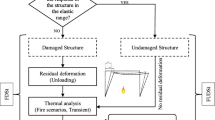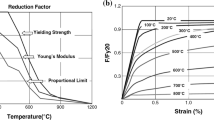Abstract
In this paper, post-earthquake fire modeling was studied in steel structures with different levels of ground motion intensity. Three-story structure modeling was implemented under post-earthquake fire by using the OpenSees software. The performance of the structure was investigated under different levels of ground motion intensity to the level of life safety. The structure was subjected to seismic and thermal analysis by applying standard fire load up to 880 s of fire. The 9-point thermal gradient for beam and column profiles under heat was analyzed by heat transfer analysis in the software. By comparing obtained results from the seismic analysis and post-earthquake fire analysis, it can be seen that for different levels of ground motion intensity, the behavior of the structure is different when it is exposed to post-earthquake fire than being exposed to the earthquake alone, which can affect the performance-based design of the structure. Therefore, in the design of structures, the effect of post-earthquake fire should be taken into account, considering the seismic zone of the structure and the time required to extinguish the fire.




















Similar content being viewed by others
References
ASCE. (2005). Minimum design loads for buildings and other structures: SEI∕ ASCE 7–05. In 2005: ASCE Reston.
ASTM. (2006). Standard test methods for determining effects of large hydrocarbon pool fires on structural members and assemblies. ASTM E1529–06. https://www.astm.org/DATABASE.CART/HISTORICAL/E1529-06.htm.
Behnam, B. (2016). Structural response of vertically irregular tall moment-resisting steel frames under pre-and post-earthquake fire. The Structural Design of Tall and Special Buildings, 25(12), 543–557.
Behnam, B. (2017). Post-earthquake fire analysis in urban structures: Risk management strategies. CRC Press.
Behnam, B. (2018). Failure sensitivity analysis of tall moment-resisting structures under natural fires. International Journal of Civil Engineering, 16(12), 1771–1780.
Behnam, B., & Ronagh, H. (2013). A post-earthquake fire factor to improve the fire resistance of damaged ordinary reinforced concrete structures. Journal of structural fire engineering. https://doi.org/10.1260/2040-2317.4.4.207
Chen, J., & Young, B. (2006). Stress–strain curves for stainless steel at elevated temperatures. Engineering Structures, 28(2), 229–239.
Della Corte, G., Landolfo, R., & Mazzolani, F. (2003). Post-earthquake fire resistance of moment resisting steel frames. Fire Safety Journal, 38(7), 593–612.
EN 1993–1–1 (2005). Eurocode 3: Design of steel structures - Part 1-1: General rules and rules for buildings [Authority: The European Union Per Regulation 305/2011, Directive 98/34/EC, Directive 2004/18/EC]
FEMA. (2000). Prestandard and commentary for the seismic rehabilitation of buildings (FEMA356) (p. 7). Federal Emergency Management Agency.
FEMA, P 695 (2009). Quantification of building seismic performance factors: US Department of Homeland Security.
Franssen, J.-M., & Gernay, T. (2019). User’s manual for SAFIR 2019 A computer program for analysis of structures subjected to fire. University of Liege, Department ArGEnCO, Service Structural Engineering.
Franssen, J.-M., & Real, P. V. (2012). Fire design of steel structures: Eurocode 1: Actions on structures; Part 1–2: General actions–Actions on structures exposed to fire; Eurocode 3: Design of steel structures; Part 1–2: General rules—Structural fire design. Wiley.
Ghojel, J. I., & Wong, M. (2005). Three-sided heating of I-beams in composite construction exposed to fire. Journal of Constructional Steel Research, 61(6), 834–844.
International Standard ISO 834–1 (1999). Fire Resistance Tests - Elements of Building Construction - Part 1: General Requirements
Khorasani, N. E., & Garlock, M. E. (2017). Overview of fire following earthquake: Historical events and community responses. International Journal of Disaster Resilience in the Built Environment. https://doi.org/10.1108/IJDRBE-02-2015-0005
Khorasani, N. E., Garlock, M. E., & Quiel, S. E. (2015). Modeling steel structures in OpenSees: Enhancements for fire and multi-hazard probabilistic analyses. Computers and Structures, 157, 218–231.
Krawinkler, H. (2000). State of art report on systems performance of moment resisting steel frames subject to earthquake ground shaking. FEMA 355c.
Lewis, K. R. (2000). Fire design of steel members.
Lignos, D. G., & Krawinkler, H. (2011). Deterioration modeling of steel components in support of collapse prediction of steel moment frames under earthquake loading. Journal of Structural Engineering, 137(11), 1291–1302.
Mazzoni, S., McKenna, F., Scott, M. H., & Fenves, G. L. (2006). OpenSees command language manual. Pacific Earthquake Engineering Research (PEER) Center, 264. https://opensees.berkeley.edu/OpenSees/manuals/usermanual/index.html.
Memari, M., Mahmoud, H., & Ellingwood, B. (2014). Post-earthquake fire performance of moment resisting frames with reduced beam section connections. Journal of Constructional Steel Research, 103, 215–229.
PEER. (2014). PEER NGA-West2 database, PEER report 2013/03. Berkeley: University of California.
Quiel, S. E., & Garlock, M. E. (2010). Closed-form prediction of the thermal and structural response of a perimeter column in a fire. The Open Construction and Building Technology Journal. https://doi.org/10.2174/1874836801004010064
Rubert, A., & Schaumann, P. (1986). Structural steel and plane frame assemblies under fire action. Fire Safety Journal, 10(3), 173–184.
Ryder, N. L., Wolin, S. D., & Milke, J. A. (2002). An investigation of the reduction in fire resistance of steel columns caused by loss of spray-applied fire protection. Journal of Fire Protection Engineering, 12(1), 31–44.
SAP C. (2009). Version 14 Integerated finite element analysis and design of structures Basic analysis references manual. Computers and Structures Inc.
Systèmes, D. (2007). Abaqus analysis user’s manual. Simulia Corp. Providence, RI, USA. http://130.149.89.49:2080/v6.10/pdf_books/ANALYSIS_3.pdf
Tanaka, T., Hagiwara, I., Harada, K., Ohmiya, Y., Mizuno, M., Yamaguchi, J., et al. (1998). Performance-based fire safety design of a high-rise office building. In Proceedings of the Second International Conference on Performance-Based Codes and Fire Safety Design Methods, Building Research Institute. Japan.
Tomecek, D. V., & Milke, J. A. (1993). A study of the effect of partial loss of protection on the fire resistance of steel columns. Fire Technology, 29(1), 3–21.
UBC, B. S. S. C. (1994). Edition NEHRP Recommended Provisions for Seismic Regulations for New Buildings. Issued by FEMA in furtherance of the Decade for Natural Disaster Reducation, Federal Emergency Management Agency.
Venture, S. J., & Sacramento, C. (1994). Invitational workshop on steel seismic issues. Proc., Rep. SAC, 94, 1.
Wang, W.-Y., & Li, G.-Q. (2009). Fire-resistance study of restrained steel columns with partial damage to fire protection. Fire Safety Journal, 44(8), 1088–1094.
Zaharia, R., & Pintea, D. (2009). Fire after earthquake analysis of steel moment resisting frames. International Journal of Steel Structures, 9(4), 275–284.
Author information
Authors and Affiliations
Corresponding author
Additional information
Publisher's Note
Springer Nature remains neutral with regard to jurisdictional claims in published maps and institutional affiliations.
Rights and permissions
About this article
Cite this article
Pourkeramat, P., Ghiasi, V. & Mohebi, B. The Effect of Post-Earthquake Fire on the Performance of Steel Moment Frames Subjected to Different Ground Motion Intensities. Int J Steel Struct 21, 1197–1209 (2021). https://doi.org/10.1007/s13296-021-00496-9
Received:
Accepted:
Published:
Issue Date:
DOI: https://doi.org/10.1007/s13296-021-00496-9




